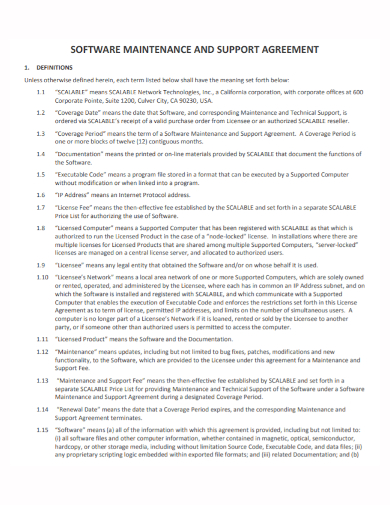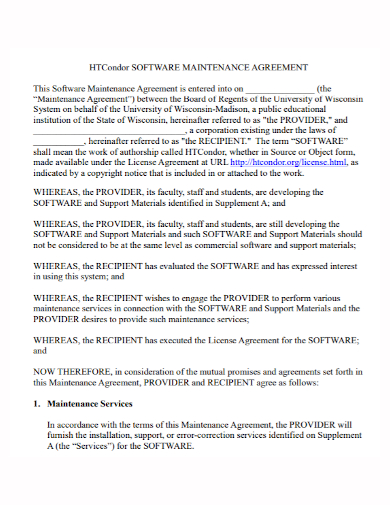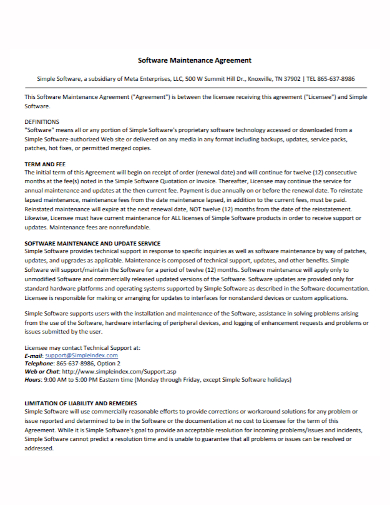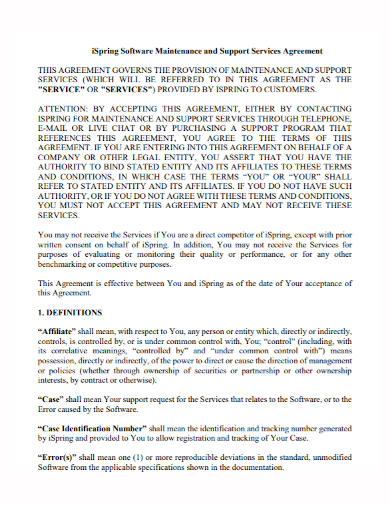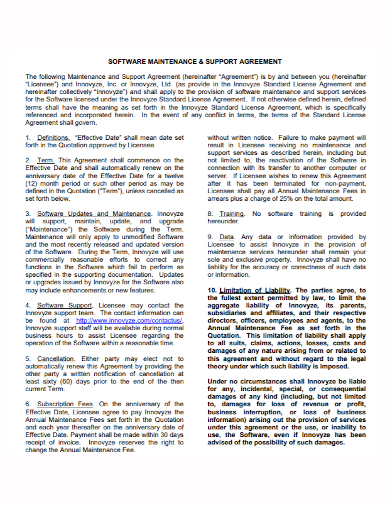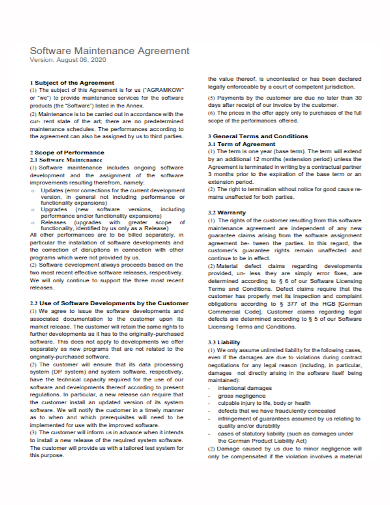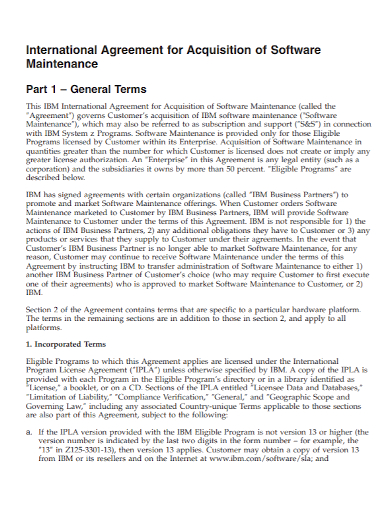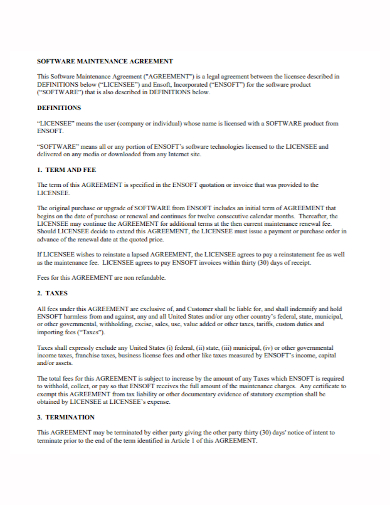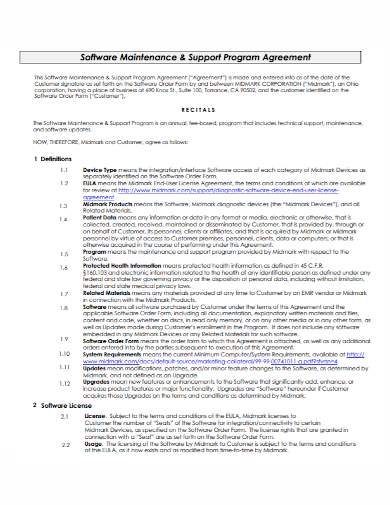Information Technology is one of the industry’s most refurbished domains. It continuously recognizes technological advances that improve the efficiency of problem-solving in order to streamline business operations. To stay ahead of the competition, you’ll need to follow the latest enterprise software development trends. The system is regularly upgraded with new and smart technologies, and it runs smoothly and efficiently under maintenance management. Software maintenance is just as important as software development. It keeps solutions agile in order to deal with changing technology and business conditions. Traditionally, IT service providers advise their customers to use software maintenance services to ensure the system’s improved and consistent performance.
10+ Software Maintenance Agreement Samples
The method of changing, modifying, and updating software to keep up with customer needs is known as software maintenance. After a product has been released, software maintenance is performed for a variety of reasons, including improving the software overall, correcting issues or bugs, increasing performance, and more. The SDLC includes software maintenance as a natural part of the process (software development life cycle). Software developers don’t have the luxury of releasing a product and then leaving it alone; they must constantly correct and improve their code in order to stay competitive and relevant.
1. Software Maintenance Agreement Template
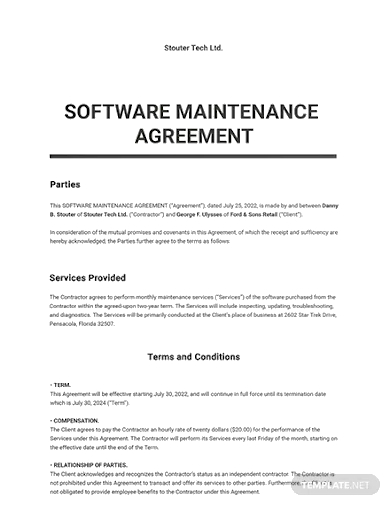
2. Software Maintenance Agreement VAR Template
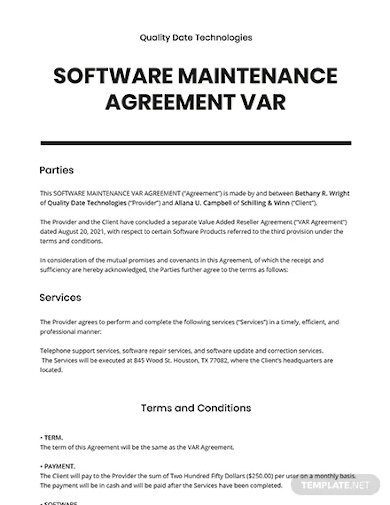
3. Software Maintenance and Support Agreement
4. Software Maintenance Services Agreement
5. Software Maintenance Agreement
6. Software Maintenance and Support Services Agreement
7. Sample Software Maintenance Agreement
8. Standard Software Maintenance Agreement
9. Software Acquisition Maintenance Agreement
10. Basic Software Maintenance Agreement
11. Software Maintenance Program Agreement
Types of Software Maintenance
- Corrective software maintenance – Corrective software maintenance is the most common and traditional type of maintenance (for software and anything else for that matter). When something goes wrong with a piece of software, such as bugs or errors, corrective software maintenance is required. These issues can have a wide impact on the software’s overall functionality, so they must be addressed as soon as possible. Due to bug reports sent in by users, software vendors are frequently able to address issues that require corrective maintenance. If a company can detect and correct flaws before users notice them, this is an added benefit that will make your company appear more reputable and trustworthy (no one likes an error message after all).
- Preventive software maintenance – Preventative software maintenance entails planning ahead of time to ensure that your software continues to function as intended for as long as possible. This includes making necessary adjustments, upgrades, and adaptations, among other things. Preventative software maintenance can address minor issues that may seem insignificant at the time but could grow into larger issues in the future. These are known as latent faults, and they must be detected and corrected to ensure that they do not become active faults.
- Perfective software maintenance – When software is released to the public, new issues and ideas emerge, just as they do with any other product. Users may see the need for additional features or requirements in the software in order to make it the best tool for their needs. Perfective software maintenance comes into play at this point. Perfective software maintenance aims to fine-tune software by adding new features as needed and removing features that are no longer relevant or effective in the current software. As the market and user needs evolve, this process ensures that software remains relevant.
- Adaptive software maintenance – Adaptive software maintenance is concerned with changing technologies as well as your software’s policies and rules. Changes to the operating system, cloud storage, and hardware are just a few examples. When these modifications are made, your software must adapt in order to meet the new requirements and continue to function properly.
FAQs
What are some of the challenges in software maintenance?
- Any software program’s popular age is taken into account for ten to fifteen years. Because software program renovation is an open-ended process that can last for decades, it is very costly.
- Older software programs, which were designed to run on slow machines with limited reminiscence and storage, are unable to compete with newer, more powerful software on modern hardware.
- Changes are frequently left undocumented, which can lead to increased conflict in the future.
- The cost of preserving vintage software programs rises as time passes.
- Frequently, changes made can unintentionally harm the software program’s original shape, making future adjustments difficult.
Why does software requires maintenance?
- Bug fixing is a top priority in maintenance management in order to keep the software running smoothly.
- This includes enhancements to features and functions to make solutions more adaptable to changing market conditions. It improves system workflow by improving software platforms, work patterns, hardware upgrades, compilers, and other factors.
- Unwanted features are rendered useless. Furthermore, by taking up space in the solution, they reduce its efficiency. Such UI and coding elements are removed and replaced with new development using the latest tools and technologies using a software maintenance guide.
- Developers use testing to identify and resolve issues in order to improve system performance. Software maintenance includes data and coding restraints, as well as reengineering.
Software maintenance isn’t a choice; it’s a necessity. Consider your automobile, for example. If you don’t keep up with your vehicle’s maintenance, it can cause a lot of problems. Furthermore, the bill for uncompleted vehicle maintenance will be higher than the cost of a regular inspection or maintenance. Similarly, if software maintenance is not taken seriously in your business plan, there will be less room for optimal growth.
Related Posts
FREE 26+ Investment Agreement Samples in PDF | MS Word | Google Docs | Pages
Land Purchase Agreement Samples & Templates
Sample Business Agreement between Two Parties
FREE 10+ Trial Agreement Samples In MS Word | Google Docs | Apple Pages | PDF
FREE 10+ Charter Agreement Samples In MS Word | Google Docs | Apple Pages | PDF
FREE 10+ Mentoring Agreement Samples In MS Word | Apple Pages | PDF
FREE 10+ Partner Agreement Samples In MS Word | Google Docs | Apple Pages | PDF
FREE 10+ Individual Agreement Samples In MS Word | Google Docs | Apple Pages | PDF
FREE 10+ Strategic Agreement Samples In MS Word | Google Docs | Apple Pages | PDF
FREE 10+ Producer Agreement Samples in MS Word | Apple Pages | PDF
FREE 10+ Grant Agreement Samples In MS Word | Apple Pages | PDF
FREE 8+ Meeting Agreement Samples in MS Word | Google Docs | Apple Pages | PDF
FREE 10+ Community Agreement Samples In MS Word | Google Docs | PDF
FREE 8+ Real Estate Option Agreement Samples in MS Word | PDF
FREE 10+ Call Option Agreement Samples In MS Word | PDF

